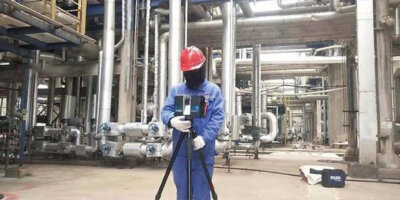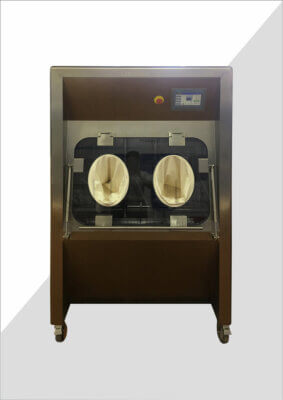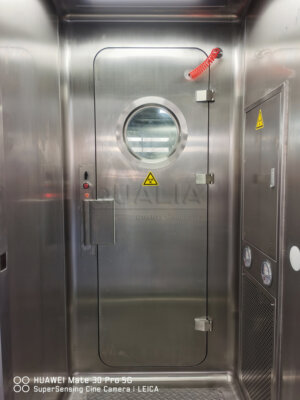Effluent decontamination systems play a crucial role in maintaining biosafety and environmental protection in laboratories and research facilities. These systems are designed to treat and neutralize potentially hazardous liquid waste before it's released into the environment. However, the effectiveness of these systems relies heavily on proper validation protocols. This article delves into the intricate world of validation protocols for effluent decontamination systems, exploring their importance, methodologies, and best practices.
The validation of effluent decontamination systems is a complex process that involves multiple steps and considerations. From initial design and commissioning to ongoing monitoring and maintenance, each phase requires careful attention to detail and adherence to strict guidelines. This article will examine the key components of validation protocols, including biological testing, system verification, and quality control measures. We'll also discuss the challenges faced in the validation process and how industry experts are addressing these issues to ensure the highest levels of safety and compliance.
As we explore this critical aspect of biosafety, we'll transition from the broader context of effluent decontamination to the specific protocols and methodologies used in their validation. Understanding these processes is essential for laboratory managers, biosafety officers, and regulatory compliance professionals who are responsible for maintaining safe and effective waste management systems.
Proper validation of effluent decontamination systems is essential for ensuring the safe disposal of potentially hazardous biological waste and protecting both human health and the environment.
| Validation Component | Purpose | Frequency |
|---|---|---|
| Biological Testing | Verify system's ability to inactivate microorganisms | Annually |
| System Component Verification | Ensure all components are functioning correctly | Quarterly |
| Chemical Efficacy Testing | Confirm decontamination chemicals are effective | Bi-annually |
| Temperature Monitoring | Validate system maintains required temperatures | Continuous |
| Effluent Quality Analysis | Assess treated effluent for compliance with standards | Monthly |
Why are validation protocols crucial for effluent decontamination systems?
Validation protocols are the backbone of effective effluent decontamination systems. They provide a structured approach to verifying that these critical safety systems are functioning as intended, capable of neutralizing potential biohazards before they enter the wider environment.
The importance of these protocols cannot be overstated. They serve as a safeguard against the release of dangerous pathogens, ensure compliance with regulatory standards, and provide confidence in the overall biosafety measures of a facility.
Implementing robust validation protocols is not just a matter of regulatory compliance; it's a fundamental responsibility in protecting public health and the environment. These protocols help identify potential weaknesses in the system, allowing for timely interventions and improvements.
Validation protocols for effluent decontamination systems are essential for maintaining biosafety standards, ensuring regulatory compliance, and protecting both laboratory personnel and the general public from potential biological hazards.
| Protocol Component | Benefits |
|---|---|
| Regular Testing | Early detection of system failures |
| Documentation | Traceability and audit readiness |
| Performance Benchmarking | Continuous system improvement |
| Risk Assessment | Proactive hazard mitigation |
How are biological indicators used in validation protocols?
Biological indicators are a cornerstone of validation protocols for effluent decontamination systems. These specially prepared microorganisms serve as a litmus test for the system's efficacy in neutralizing potential biohazards.
The use of biological indicators involves introducing known concentrations of resistant microorganisms into the system and then evaluating their survival after treatment. This process provides tangible evidence of the system's ability to inactivate even the most resilient pathogens.
Selecting the appropriate biological indicators is crucial and depends on the specific pathogens a facility handles. For instance, bacterial spores are often used due to their high resistance to various decontamination methods. The QUALIA Effluent Decontamination System is designed to effectively neutralize a wide range of biological agents, ensuring comprehensive protection.
Biological indicators provide a reliable method for validating the performance of effluent decontamination systems by demonstrating their ability to inactivate highly resistant microorganisms under actual operating conditions.
| Biological Indicator | Application | Resistance Level |
|---|---|---|
| Geobacillus stearothermophilus | Heat-based systems | High heat resistance |
| Bacillus atrophaeus | Chemical-based systems | High chemical resistance |
| Bacillus subtilis | Radiation-based systems | High radiation resistance |
What role does system component verification play in validation?
System component verification is a critical aspect of validation protocols for effluent decontamination systems. This process ensures that each part of the system is functioning correctly and contributes to the overall effectiveness of the decontamination process.
Component verification typically involves a series of checks and tests on various parts of the system, including pumps, valves, sensors, and control systems. These checks help identify any malfunctions or deterioration that could compromise the system's performance.
Regular system component verification not only helps maintain the integrity of the decontamination process but also contributes to the longevity of the equipment. By identifying and addressing issues early, facilities can avoid costly breakdowns and ensure continuous protection against biohazards.
Thorough and regular system component verification is crucial for maintaining the reliability and effectiveness of effluent decontamination systems, ensuring that all parts work together seamlessly to neutralize potential biological threats.
| Component | Verification Method | Frequency |
|---|---|---|
| Pumps | Flow rate testing | Monthly |
| Valves | Leak testing | Quarterly |
| Sensors | Calibration checks | Bi-annually |
| Control Systems | Software diagnostics | Weekly |
How do chemical efficacy tests contribute to validation protocols?
Chemical efficacy tests are an integral part of validation protocols for effluent decontamination systems that rely on chemical treatments. These tests ensure that the chemicals used in the decontamination process are effective at neutralizing potential biohazards.
The process typically involves testing the concentration and potency of the decontamination chemicals at various points in the system. This includes checking the initial chemical dosing as well as the residual chemical levels after treatment.
Chemical efficacy tests also help in optimizing the decontamination process. By understanding the effectiveness of different chemical concentrations and contact times, facilities can fine-tune their systems for maximum efficiency while ensuring complete inactivation of pathogens.
Chemical efficacy tests are crucial for validating the performance of chemically-based effluent decontamination systems, ensuring that the right concentration of active chemicals is maintained throughout the treatment process for optimal pathogen inactivation.
| Chemical Test | Purpose | Frequency |
|---|---|---|
| Concentration Analysis | Verify correct chemical dosing | Daily |
| Residual Testing | Ensure sufficient chemical activity | Per batch |
| pH Monitoring | Optimize chemical effectiveness | Continuous |
| Oxidation-Reduction Potential | Assess overall disinfection potential | Hourly |
What are the key considerations in temperature monitoring for validation?
Temperature monitoring is a critical component of validation protocols, particularly for thermal-based effluent decontamination systems. Maintaining the correct temperature throughout the treatment process is essential for ensuring the inactivation of pathogens.
Effective temperature monitoring involves continuous measurement at multiple points within the system. This includes monitoring the heating process, the hold time at the target temperature, and the cooling phase. Advanced systems, like those offered by QUALIA, often incorporate real-time temperature monitoring with automated alarms for any deviations.
It's important to note that temperature requirements can vary depending on the types of pathogens being treated. Validation protocols must ensure that the system can consistently achieve and maintain the temperatures necessary for complete inactivation of the most heat-resistant organisms likely to be present in the effluent.
Accurate and continuous temperature monitoring is essential for validating thermal-based effluent decontamination systems, ensuring that all pathogens are exposed to lethal temperatures for the required duration to achieve complete inactivation.
| Monitoring Point | Purpose | Measurement Frequency |
|---|---|---|
| Heating Phase | Ensure rapid temperature rise | Every 30 seconds |
| Hold Phase | Verify maintenance of target temperature | Every minute |
| Cooling Phase | Prevent thermal shock to system | Every 30 seconds |
| System Outflow | Confirm safe discharge temperature | Continuous |
How is effluent quality analysis incorporated into validation protocols?
Effluent quality analysis is a crucial final step in the validation protocols for effluent decontamination systems. This process involves testing the treated effluent to ensure it meets all safety and regulatory standards before release into the environment.
The analysis typically includes a range of tests, from basic parameters like pH and turbidity to more specific tests for microbial content and chemical residues. Advanced techniques such as polymerase chain reaction (PCR) may be used to detect any remaining genetic material from pathogens.
Regular effluent quality analysis not only validates the effectiveness of the decontamination system but also provides valuable data for trend analysis and system optimization. It serves as the last line of defense in preventing the release of potentially hazardous materials into the environment.
Comprehensive effluent quality analysis is a critical component of validation protocols, providing definitive evidence of the effectiveness of the decontamination process and ensuring compliance with environmental safety regulations.
| Test Parameter | Method | Frequency |
|---|---|---|
| Microbial Content | Culture-based assays | Per batch |
| Chemical Residues | Spectrophotometry | Weekly |
| pH | Digital pH meter | Continuous |
| Turbidity | Nephelometry | Daily |
What documentation and record-keeping practices are essential for validation protocols?
Documentation and record-keeping are fundamental aspects of validation protocols for effluent decontamination systems. These practices provide a paper trail that demonstrates compliance with regulatory requirements and facilitates continuous improvement of the system.
Comprehensive documentation should include detailed records of all validation tests, system maintenance activities, and any deviations or corrective actions taken. This information is crucial for regulatory inspections and internal audits, and it helps in identifying trends or recurring issues over time.
Effective record-keeping also supports the development of standard operating procedures (SOPs) and training programs. By analyzing historical data, facilities can refine their protocols and improve the overall efficiency and reliability of their effluent decontamination systems.
Thorough documentation and record-keeping are essential components of validation protocols, providing transparency, traceability, and valuable insights for continuous improvement of effluent decontamination systems.
| Documentation Type | Content | Retention Period |
|---|---|---|
| Validation Test Reports | Test results, parameters, and outcomes | 5 years |
| Maintenance Logs | Service dates, actions taken, parts replaced | Life of equipment |
| Training Records | Staff training dates, topics covered | Duration of employment + 3 years |
| Incident Reports | Details of system failures or deviations | 10 years |
In conclusion, validation protocols for effluent decontamination systems are complex but essential processes that ensure the safe handling and disposal of potentially hazardous biological waste. These protocols encompass a wide range of activities, from biological testing and system component verification to chemical efficacy testing and effluent quality analysis. Each component plays a crucial role in maintaining the integrity and effectiveness of the decontamination system.
The importance of these validation protocols cannot be overstated. They serve as the foundation for biosafety in laboratories and research facilities, protecting not only the immediate environment but also public health at large. By implementing robust validation protocols, facilities can ensure that their effluent decontamination systems are functioning optimally, capable of neutralizing even the most resistant pathogens.
As technology and research practices continue to evolve, so too must the approaches to validation. Staying abreast of the latest developments in validation methodologies and incorporating advanced technologies like those offered by QUALIA is crucial for maintaining the highest standards of biosafety.
Ultimately, the goal of these validation protocols is to provide confidence – confidence in the safety of laboratory operations, in the protection of the environment, and in the overall integrity of scientific research. By adhering to rigorous validation protocols, facilities can ensure that they are not only complying with regulatory requirements but also upholding their ethical responsibility to safeguard public health and the environment.
External Resources
Effluent Decontamination Systems (EDS): Annual Verification and General Maintenance – This document from the Federal Select Agent Program details the annual verification and maintenance requirements for effluent decontamination systems, including biological validation, system component verification, and preventative maintenance.
Verification Protocol for Secondary Effluent and Water Reuse Disinfection Applications – Although focused on water reuse, this EPA protocol provides a framework for verifying the performance of disinfection equipment, which can be adapted for effluent decontamination systems, emphasizing planning, testing, and quality control.
Biosafety in Microbiological and Biomedical Laboratories (BMBL) – CDC – The BMBL guidelines from the CDC and NIH require laboratories to develop and implement decontamination programs, including the validation of effluent decontamination systems to ensure safe disposal of biological waste.
Effluent Decontamination Systems: Addressing the Challenges of Validation – This article from Applied Biosafety discusses the planning, design, commissioning, and biological validation of effluent decontamination systems, emphasizing the importance of strict biological protocols and direct validation methods.
Effluent Decontamination systems – Belgian Biosafety Server – This document outlines the importance of onsite validation under exact operating conditions for effluent decontamination systems. It also discusses the need to determine adequate temperature and chemical combinations for agent inactivation.
Related Contents:
- Effluent Decontamination: Essential for High-Risk Labs
- Continuous Effluent Decontamination: Protecting Our Environment
- Effluent Decontamination Systems for Biosafety Laboratories
- Thermal Effluent Decontamination: Protecting Our Environment
- Effluent Decontamination: Safeguarding Our Environment
- Effluent Decontamination Systems: Safeguarding Labs and Beyond
- Streamlining Effluent Decontamination: Continuous vs. Batch Processing
- Effluent Decontamination Systems: Safeguarding Malaysia’s Environment
- Effluent Decontamination: Ensuring Pharmaceutical Safety






























